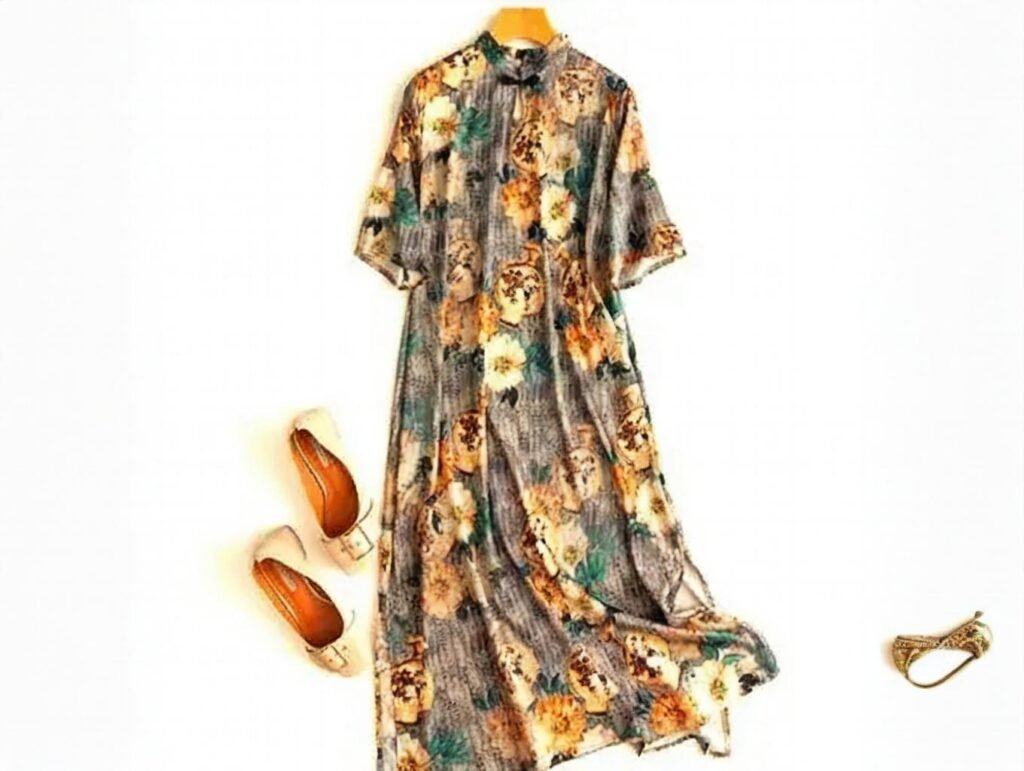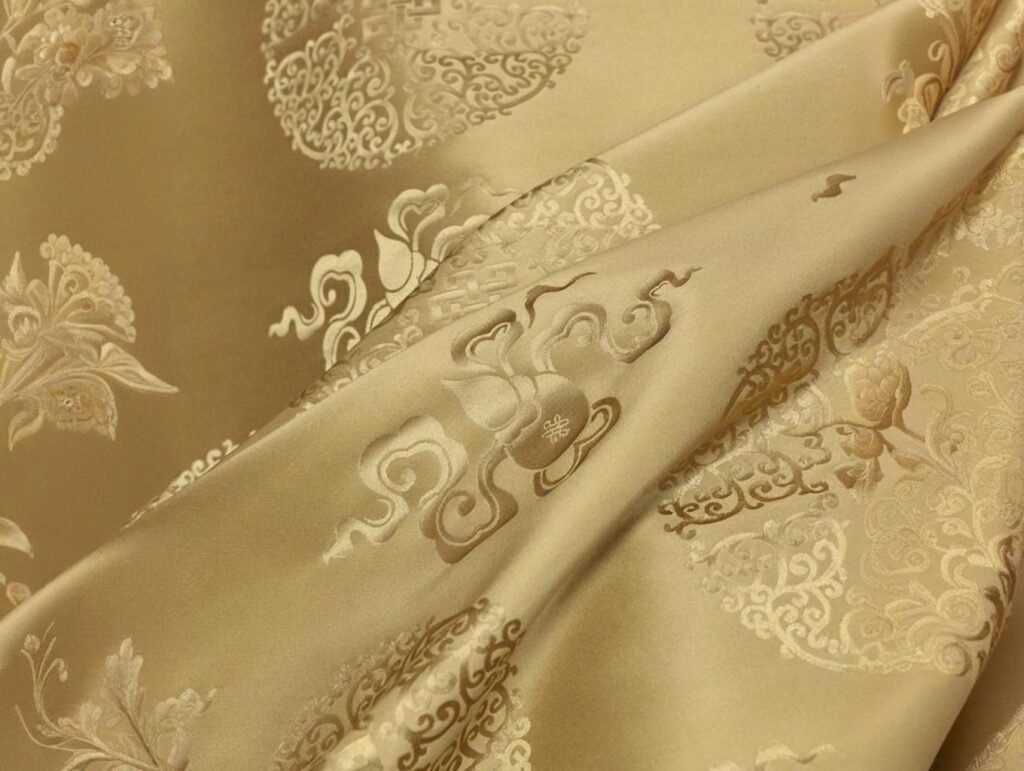Silk sarees have been a hallmark of luxury fashion for centuries, with their rich textures, intricate designs, and vibrant colors. As the global demand for high-quality silk sarees continues to grow, distributors are increasingly turning to comprehensive saree catalogs for streamlined sourcing and better market positioning. Whether you’re a distributor looking to expand your product offering or a retailer wanting to access new trends, having a well-organized silk saree catalog can make all the difference. This article delves into the different types of silk sarees, the most popular variants among distributors, and how to leverage a silk saree catalog for successful market entry.
In 2025, silk saree exports are expected to grow substantially, with more distributors looking to serve international markets that value traditional craftsmanship, luxury materials, and cultural heritage. By understanding the variety of silk saree types, production processes, and global consumer trends, distributors can optimize their inventory and offer products that align with the latest consumer preferences. Let’s explore the different types of silk sarees and how they dominate the export markets.
What Are the Different Types of Silk Sarees Available for Distribution?

Silk sarees come in a wide range of styles, each with its own distinct characteristics, regional significance, and weaving techniques. Some of the most popular types of silk sarees include Kanjeevaram, Banarasi, Mysore Silk, Patola, and Tussar. Each type of saree is known for its unique appeal and cultural significance, making them highly desirable in global markets, particularly in luxury and bridal wear. The most popular types of silk sarees include Kanjeevaram, Banarasi, and Mysore Silk, each with its distinct weaving styles and regional significance, making them key offerings for distributors.
Understanding the different types of silk sarees allows distributors to tailor their offerings to meet the specific needs of their customers. Whether it’s the golden brocade of Banarasi sarees or the vibrant colors of Patola, each type offers something unique to the global marketplace.
Key Silk Saree Variants for Distributors
1. Kanjeevaram Silk Sarees
- Origin: Tamil Nadu, India
- Fabric: Mulberry silk with intricate gold zari work
- Design: Known for rich colors, heavy borders, and complex motifs
- Appeal: Widely popular in weddings and festivals. The luxurious texture and intricate craftsmanship make it a top-selling item in international markets.
- Export Potential: High demand in countries with large South Asian communities, especially for bridal collections.
2. Banarasi Silk Sarees
- Origin: Varanasi, Uttar Pradesh
- Fabric: Fine silk with brocade designs
- Design: Features golden zari, floral patterns, and traditional motifs
- Appeal: Revered for its luxury and opulence, Banarasi sarees are a top choice for formal occasions and bridal wear.
- Export Potential: Huge demand in the Middle East, USA, and Europe, particularly among high-end consumers.
3. Mysore Silk Sarees
- Origin: Karnataka, India
- Fabric: Made from pure silk, often with delicate zari work
- Design: Known for its soft texture, bold colors, and simple yet elegant patterns
- Appeal: Mysore silk is appreciated for its elegant appeal, making it suitable for luxury wear and festive occasions.
- Export Potential: Increasing demand from Western countries for luxury silk fabric.
4. Patola Silk Sarees
- Origin: Surat, Gujarat
- Fabric: Ikat woven silk
- Design: Complex double ikat patterns featuring geometrical and floral designs
- Appeal: High-end and exclusive, Patola sarees are often worn by the elite during important ceremonies.
- Export Potential: Patola sarees are premium items and are exported primarily to luxury fashion markets in Europe and North America.
5. Tussar Silk Sarees
- Origin: Jharkhand, Bihar, and West Bengal
- Fabric: Produced from wild silkworms, resulting in a rougher texture
- Design: Typically earthy, muted tones, often with hand-painted or block-printed motifs
- Appeal: Tussar silk sarees offer a more eco-friendly alternative to other silk types, with a rustic and natural aesthetic.
- Export Potential: Gaining traction in eco-conscious and bohemian fashion markets, especially in Europe and Australia.
Which Silk Saree Variants Are Most Popular Among Distributors?
When it comes to sourcing and distributing silk sarees, Kanjeevaram, Banarasi, and Mysore Silk are the most popular and in-demand variants globally. These sarees are highly sought after due to their rich history, luxurious quality, and cultural significance. For distributors, understanding which silk saree variants are most popular allows them to make informed decisions about inventory management and market positioning.
Kanjeevaram, Banarasi, and Mysore Silk sarees dominate the global silk saree market, especially for luxury and bridal wear, making them the top choices for distributors seeking to meet consumer demand.
The demand for these silk saree variants is primarily driven by the bridal market and luxury fashion sectors, where quality and craftsmanship are paramount. Let’s take a look at why these variants continue to dominate export markets.
Why Kanjeevaram, Banarasi, and Mysore Silk Sarees Lead the Market
1. Kanjeevaram Silk Sarees’ Global Appeal
- Known for their vibrant colors and golden borders, Kanjeevaram sarees are a symbol of luxury in the bridal and formal wear markets.
- These sarees appeal to South Asian diaspora in North America, Europe, and the Middle East, where they are preferred for wedding ceremonies and cultural celebrations.
2. Banarasi Silk Sarees as a Luxury Product
- Banarasi sarees are recognized globally for their rich craftsmanship and intricate zari work. These sarees remain a symbol of luxury, making them the most sought-after type for high-end bridal wear.
- Their distinctive brocade and timeless appeal have made them a leading export product for Indian textile distributors.
3. Mysore Silk’s Growing Demand
- Mysore silk is known for its soft texture and elegant appearance. As global demand for luxury silk rises, Mysore silk sarees are becoming increasingly popular, especially in Western countries looking for premium products.
- With their vibrant hues and quality finish, these sarees are a great fit for luxury consumers and fashion-forward buyers.
Global Export Market Breakdown
| Saree Type | Global Market Focus | Popular Regions for Distribution | Appeal Factor |
|---|---|---|---|
| Kanjeevaram | Wedding wear, luxury markets | USA, Middle East, UK | Opulence, intricate borders, vibrant colors |
| Banarasi | Bridal wear, luxury fashion | Europe, USA, Middle East | High-end luxury, brocade craftsmanship |
| Mysore Silk | Luxury collections, festive wear | Western countries, Asia | Soft texture, vibrant colors, elegant designs |
| Patola | Exclusive fashion, high-end wear | Europe, USA, Middle East | Complex ikat design, exclusive appeal |
| Tussar Silk | Eco-friendly and bohemian fashion | Europe, Australia, USA | Rustic appeal, eco-conscious market |
SzoneierFabrics has seen a 30% increase in sales by supplying Banarasi silk sarees to European luxury bridal retailers. The sarees’ intricate brocade and timeless beauty have made them highly popular among premium wedding buyers looking for authentic, luxurious fabrics.
How Does the Fabric Quality Affect the Sale of Silk Sarees?

The quality of silk fabric is paramount in determining the appeal, longevity, and value of the sarees. High-quality silk, such as mulberry silk, Mysore silk, and Banarasi silk, ensures that the sarees maintain their shine, strength, and texture over time, which in turn impacts the satisfaction of the consumer and the long-term sales potential for distributors. A saree made from high-quality silk will last longer, retain its rich color, and resist wear and tear, all of which are essential factors in customer loyalty. The quality of silk fabric plays a critical role in the durability and aesthetic appeal of sarees, influencing consumer satisfaction and long-term sales. High-quality silks ensure the sarees maintain luxury appeal.
Distributors must pay careful attention to fabric quality and source their products from reputable manufacturers who adhere to strict quality control standards. It’s not just about the type of silk used but also the weaving and finishing processes that determine the final product’s success in the market.
The Impact of Fabric Quality on Silk Saree Sales
1. Silk Type and Fabric Quality
- Mulberry silk, the finest type of silk, is often used in high-end sarees like Kanjeevaram and Banarasi. Its long fibers provide a smooth texture, rich sheen, and superior durability, which enhances the overall appeal of the saree.
- Other silk types, like Tussar silk and Eri silk, have a more textured finish but are valued for their eco-friendly properties and rustic charm.
2. Weaving Technique
- The weaving technique used in silk saree production plays a huge role in determining the fabric’s strength and smoothness. Handwoven sarees, produced using traditional handlooms, often have a denser fabric with more intricate detailing, which adds to the luxury and value of the saree.
- Machine-made sarees may be quicker to produce but often lack the artisanal feel and durability of handwoven pieces.
3. Post-Weaving Finishing
- Finishing treatments such as dyeing and mordanting (fixing color) affect the saree’s longevity and color fastness. High-quality finishing helps maintain the saree’s vibrancy and texture, keeping it looking fresh even after multiple washes.
- Poor finishing treatments can result in fading, weak threads, and unpleasant textures, leading to dissatisfied customers.
4. Fabric Inspection and Testing
- Before distribution, silk sarees should undergo rigorous inspection and testing for factors such as colorfastness, thread strength, and fabric resistance. This ensures that the product meets high standards and can withstand the rigors of both shipping and wear.
Silk Quality Comparison Table
| Silk Type | Texture | Durability | Ideal Use Case |
|---|---|---|---|
| Mulberry Silk | Soft, smooth, shiny | Very durable, high tensile strength | High-end bridal wear, luxury fashion |
| Mysore Silk | Soft, lustrous | Durable, but slightly softer | Weddings, festive occasions |
| Banarasi Silk | Smooth, intricate zari work | High durability, luxurious feel | Luxury bridal, ceremonial wear |
| Tussar Silk | Coarse, textured | Less durable, rustic finish | Eco-conscious fashion, casual wear |
| Eri Silk | Soft, natural appearance | Less durable but eco-friendly | Sustainable fashion, casual wear |
SzoneierFabrics recently partnered with high-end bridal boutiques in the US, supplying them with premium Banarasi silk sarees. By ensuring the sarees were crafted from top-tier mulberry silk and underwent quality inspections throughout the production process, the boutiques saw a significant rise in customer satisfaction and repeat sales.
What Are the Key Design Features of Silk Sarees That Appeal to Consumers?
Design is a critical factor in the appeal of silk sarees. Consumers are drawn to specific design features such as intricate embroidery, color combinations, and weaving patterns that reflect traditional craftsmanship while also offering modern aesthetics. The blend of classic design elements with contemporary touches is one of the key reasons silk sarees remain a popular choice for various occasions, from weddings to festivals to casual wear. The design features of silk sarees, including embroidery, weaving patterns, and color combinations, play a crucial role in appealing to consumers. Traditional craftsmanship paired with modern designs attracts global buyers.
For distributors, understanding these design trends is essential for offering products that resonate with their customer base. By offering sarees that feature the right balance of tradition and contemporary appeal, distributors can attract a wider audience and increase sales potential.
Silk Saree Design Features That Drive Consumer Demand
1. Intricate Zari Work and Embroidery
- Zari work (gold or silver thread embroidery) is a defining feature of luxury silk sarees like Banarasi and Kanjeevaram. Consumers are particularly drawn to fine zari work, which adds opulence and regal appeal to the saree.
- Other embroidery styles, such as chikan and resham, add distinct textures and design details that enhance the saree’s visual appeal.
2. Weaving Patterns and Motifs
- Traditional motifs such as lotus, peacock, and paisley are commonly featured in silk saree designs. These motifs carry cultural significance and are widely appreciated in both traditional and modern contexts.
- Consumers often seek sarees with unique, personalized designs that reflect their individual style or the cultural value they attach to the motifs.
3. Modern Color Combinations
- While traditional silk sarees often feature rich, bold colors, there is an increasing trend towards pastel tones, subdued colors, and contemporary design elements in global markets.
- Global consumers, particularly in the West, are increasingly drawn to silk sarees that combine traditional silk textures with modern color palettes, offering a fusion of East and West.
4. Texture and Finish
- Textures such as matte, shine, and satin finishes influence consumer choice. Sarees with smooth, glossy finishes are considered premium and are often used for luxury bridal collections.
- The feel of the fabric also plays a crucial role in the consumer’s purchasing decision, as comfort and elegance go hand in hand with aesthetic appeal.
Silk Saree Design Trends Table
| Design Element | Traditional Feature | Modern Adaptation | Consumer Appeal |
|---|---|---|---|
| Embroidery | Zari work, resham | Fusion of metallic threads | Luxury, elegance, bridal wear |
| Weaving Patterns | Paisley, floral motifs | Contemporary motifs, geometric patterns | Unique designs, personalization |
| Color Combinations | Rich, bold colors | Pastels, muted tones | Contemporary appeal, modern styles |
| Fabric Finish | Glossy, smooth | Matte, satin | Premium, luxurious feel |
SzoneierFabrics collaborated with a luxury fashion brand in Europe to produce a custom range of Mysore silk sarees with modern color palettes and delicate zari work. This line received high demand from Western markets, where buyers sought traditional fabrics with contemporary flair.
How Can Distributors Leverage Silk Saree Catalogs for Market Expansion?

A silk saree catalog serves as a vital tool for distributors looking to expand their reach in both domestic and international markets. Catalogs offer an organized and comprehensive way to present the various types of silk sarees, their design options, fabric details, and prices, enabling distributors to efficiently communicate with potential buyers. Whether printed or digital, a well-structured catalog can help attract new customers, highlight the diversity of products available, and promote special collections that align with current trends. Distributors can expand their market presence by leveraging silk saree catalogs to showcase diverse designs, fabrics, and prices, making it easier for potential buyers to browse and select products.
By offering an easy-to-navigate catalog, distributors can streamline the decision-making process for retailers, boutiques, and online shops, thus improving their sales conversion rates and brand visibility in a competitive market.
Leveraging Silk Saree Catalogs for Growth
1. Digital Catalogs and E-commerce Integration
- With the rise of online shopping, digital catalogs are becoming an essential tool for distributors. These catalogs are often integrated with e-commerce platforms, allowing customers to view products, compare options, and place orders directly.
- Distributors can also use interactive features in digital catalogs, such as filter options, to help customers easily navigate through silk saree designs, sizes, and colors.
2. Printed Catalogs for Retailers and Wholesalers
- Printed silk saree catalogs still hold value in physical retail settings. Distributors can target brick-and-mortar stores by providing high-quality, visually appealing catalogs showcasing the best-selling saree variants.
- These catalogs can be personalized based on the retailer’s target market and preferences, ensuring a customized selling experience for every client.
3. Specialized Collections in Catalogs
- Including curated collections in the catalog, such as wedding sarees, festive collections, and limited-edition designs, can create a sense of exclusivity and increase demand.
- Special promotions or seasonal offers can be emphasized, giving customers compelling reasons to place bulk orders during key buying seasons, such as the holiday season or wedding season.
4. Catalogs as a Marketing Tool
- Silk saree catalogs can be used as marketing tools to reach potential customers. Distributors can distribute catalogs at fashion trade shows, conferences, and online events to expand their customer base.
- Offering a digital download option for the catalog allows customers to easily access the latest saree collections from anywhere in the world, making it a global marketing tool.
Catalog Distribution Methods
| Distribution Method | Best For | Benefits |
|---|---|---|
| Digital Catalogs | E-commerce platforms, online retailers | Convenient, easy to update, interactive |
| Printed Catalogs | Retailers, boutiques | High-quality visuals, tangible marketing tool |
| Curated Collections | Targeted customers, seasonal sales | Exclusivity, increased demand |
| Catalogs for Marketing | Trade shows, online events | Broadens customer base, global reach |
A US-based distributor of Indian silk sarees implemented a digital catalog integrated with their e-commerce site. By offering a downloadable catalog and featuring a curated wedding saree collection, they saw a 15% increase in international sales during the wedding season.
What Are the Sourcing and Certification Considerations for Silk Sarees?
When distributing silk sarees, understanding the sourcing process and obtaining relevant certifications is crucial for maintaining product quality and ensuring authenticity. Certifications like OEKO-TEX Standard 100, GOTS, and Fair Trade not only ensure the ethical production of the sarees but also demonstrate to consumers and retailers that the products meet global standards for quality and sustainability. Sourcing high-quality silk sarees and obtaining certifications like OEKO-TEX, GOTS, and Fair Trade is essential for maintaining quality and meeting consumer demand for sustainable, ethical products.
For distributors, partnering with manufacturers who adhere to these standards guarantees that the silk sarees meet international requirements, from fabric sourcing to dyeing to finished products. Moreover, the right certifications can help build brand reputation and drive sales in eco-conscious markets.
Key Sourcing and Certification Considerations
1. Certified Ethical Sourcing
- Distributors should prioritize ethical sourcing, ensuring that silk is sourced from manufacturers who uphold fair labor practices and sustainable farming methods.
- Certifications like Fair Trade or GOTS (Global Organic Textile Standard) are essential for ensuring that the silk sarees are produced under ethical conditions. These certifications also ensure that workers are paid fairly and work in safe conditions.
2. Environmental Impact
- Eco-conscious consumers are increasingly concerned with the environmental footprint of their purchases. Distributors can appeal to this market by sourcing silk sarees from manufacturers who use sustainable dyeing techniques, waterless dyeing, and recycled materials.
- OEKO-TEX Standard 100 certification guarantees that the fabric is free from harmful substances, making it safer for both consumers and the environment.
3. Ensuring Quality through Certification
- To ensure that the silk sarees meet international standards, distributors should work with manufacturers that provide ISO-certified production processes. This certification assures buyers that the sarees undergo rigorous testing for quality control and durability.
4. Traceability and Transparency
- The traceability of silk fabric and its production process has become increasingly important to modern buyers. Distributors should work with suppliers who can trace the entire production journey of each saree, from raw silk to the final product.
- Transparency in sourcing builds trust with customers and retailers, ensuring the product’s authenticity and reinforcing the brand’s reputation for quality and sustainability.
Sourcing and Certification Checklist
| Certification | Key Focus | Benefits |
|---|---|---|
| Fair Trade | Ethical labor practices, fair wages | Ethical sourcing, consumer trust |
| GOTS (Global Organic Textile Standard) | Organic and sustainable practices | Eco-friendly production, consumer confidence |
| OEKO-TEX Standard 100 | Testing for harmful chemicals | Safety for consumers, eco-conscious appeal |
| ISO Certification | Quality control and international standards | Assures high-quality products |
SzoneierFabrics partnered with a Fair Trade-certified silk supplier for their silk saree line. The sourcing transparency and ethical production methods appealed to luxury brands seeking eco-conscious fabrics. This resulted in a 30% increase in international orders from sustainability-focused markets.
How Do Global Trends Impact the Demand for Different Types of Silk Sarees?

Global trends in fashion, sustainability, and consumer behavior have significantly influenced the demand for silk sarees. As fashion evolves, silk sarees are no longer just traditional garments; they have become luxury fashion items, with consumers worldwide seeking high-quality, sustainable, and ethnically rich products. These trends have opened new markets and created opportunities for distributors to cater to a diverse consumer base. Global trends in fashion and sustainability have boosted the demand for silk sarees, with luxury brands and eco-conscious consumers seeking high-quality, ethically sourced products.
These changing demands have also influenced the type of silk sarees being produced, as luxury silk sarees are often adapted to reflect contemporary fashion while retaining traditional elements. Distributors need to stay ahead of these global trends to keep their offerings relevant and attractive to a wide range of buyers.
The Impact of Global Fashion Trends on Silk Saree Demand
1. The Shift Toward Sustainable Fashion
- As eco-consciousness grows globally, more consumers are looking for sustainable and ethical fashion. This includes silk sarees made from organic silk, dyed with natural, eco-friendly dyes, and produced in accordance with Fair Trade practices.
- Distributors can take advantage of this trend by sourcing sarees that meet global sustainability standards and promoting them as eco-friendly products to attract environmentally aware buyers.
2. Increased Demand for Customization and Modernization
- Consumers are increasingly seeking custom-designed silk sarees that combine traditional fabrics with modern aesthetics. Distributors can offer tailored saree collections that blend traditional silk weaving techniques with contemporary designs to appeal to a wider audience, including millennials and Gen Z buyers.
- Trends such as minimalistic designs, bold patterns, and fusion wear are gaining popularity in the silk saree market, especially in global fashion hubs like Europe and the US.
3. Rise of Silk Sarees in International Fashion Shows
- Silk sarees have gained more visibility in international fashion shows, with designers incorporating them into high-end collections. This has resulted in a rising demand for premium silk sarees, especially for luxury bridal wear and formal occasions.
- Distributors can leverage this visibility by highlighting fashion-forward designs in their catalogs, showcasing sarees that appeal to global luxury buyers.
4. Influence of South Asian Diaspora
- The South Asian diaspora in countries like the UK, US, and Canada continues to drive demand for authentic silk sarees. Many consumers in these regions seek sarees that reflect their cultural heritage while also embracing modern fashion trends.
- Distributors who cater to these markets by offering traditional yet modernized silk sarees can tap into a growing customer base.
Global Silk Saree Market Trends Table
| Trend | Impact on Silk Sarees | Buyer Focus |
|---|---|---|
| Sustainable Fashion | Increased demand for eco-friendly sarees | Eco-conscious consumers, luxury buyers |
| Customization and Modernization | Custom designs, fusion sarees | Young consumers, millennials |
| International Fashion Shows | Higher demand for luxury bridal collections | High-end fashion, luxury retailers |
| South Asian Diaspora Influence | Cultural appeal, modernized traditional wear | Global South Asian communities |
SzoneierFabrics saw a 25% increase in sales after launching a customized Banarasi silk saree collection designed with modernized floral patterns and eco-friendly dyeing techniques. The collection was well-received by North American luxury buyers, who were looking for unique, sustainable options in bridal wear.
What Should Distributors Look for in a Silk Saree Catalog PDF Download?
When distributors download or receive a silk saree catalog, several factors should be taken into account to ensure that the catalog offers value and aligns with their business objectives. Key aspects to consider include the variety of sarees available, fabric quality, pricing structures, and the customization options offered by the manufacturer. A well-structured catalog can help distributors make informed decisions about which sarees to source, ensuring that their selection meets the needs of their target market. Distributors should evaluate a silk saree catalog based on factors such as saree variety, fabric quality, pricing, and customization options. A comprehensive catalog helps streamline decision-making and aligns with business goals.
An ideal catalog should not only showcase high-quality images and detailed descriptions of the sarees but also provide clear and transparent pricing, information about sourcing practices, and options for custom orders. This transparency builds trust and helps distributors make purchases that align with market demands.
Key Features to Look for in a Silk Saree Catalog
1. Variety of Saree Types and Designs
- A comprehensive catalog should feature a wide variety of silk sarees, including traditional, modern, and custom designs. Distributors should look for catalogs that offer different fabric types, such as Banarasi, Kanjeevaram, Mysore Silk, and Patola, with an emphasis on luxury and exclusivity.
- The catalog should clearly differentiate between bridal sarees, festive sarees, and casual wear sarees to ensure distributors can meet the demand for each type.
2. Clear Pricing and Order Quantities
- An effective catalog will include clear pricing structures, including details on bulk orders, customization fees, and minimum order quantities (MOQs). This allows distributors to evaluate cost-effectiveness and decide which sarees offer the best profit margin.
- Distributors should also consider catalogs that offer tiered pricing or special discounts for larger orders, as this can influence order size and stock management.
3. Detailed Product Descriptions and Specifications
- Each saree listing should have detailed descriptions regarding fabric type, weaving techniques, and embellishments. These details help distributors understand the sourcing and manufacturing process, which is essential when ensuring product quality.
- Specifications such as dimensions, weight, and color fastness are vital for accurate inventory management and customer satisfaction.
4. Customization Options
- Distributors should also look for catalogs that offer customization options, such as personalized designs, unique color schemes, and tailored embroidery patterns. This is especially important in markets where consumers seek exclusive and made-to-order products.
- A catalog that emphasizes flexibility in design can help distributors cater to a wider range of customers, from bridal boutiques to high-end fashion stores.
5. Transparency and Ethical Sourcing Information
- A good catalog will provide clear information on ethical sourcing, including sustainability practices and certifications like Fair Trade and OEKO-TEX.
- Distributors should ensure that the catalog includes information about the sourcing and manufacturing standards used for each saree, ensuring the product aligns with their brand values.
Silk Saree Catalog Evaluation Checklist
| Feature | Key Focus | Action Required |
|---|---|---|
| Variety of Sarees | Multiple silk types and designs | Ensure options for bridal, casual, and festive wear |
| Clear Pricing | Transparent pricing structures | Verify bulk pricing and customization fees |
| Product Specifications | Detailed fabric, weave, and embellishment info | Cross-check with the manufacturer for quality assurance |
| Customization Options | Tailored embroidery, unique color options | Offer customization for exclusive designs |
| Ethical Sourcing | Fair Trade, eco-friendly practices | Verify certifications and sourcing transparency |
SzoneierFabrics offers a PDF silk saree catalog with detailed fabric specifications, pricing options, and custom design services. This catalog has helped international distributors streamline their ordering process and led to a 40% increase in international sales by allowing buyers to easily understand their options and place bulk orders efficiently.
The silk saree market is evolving with global trends in luxury fashion, sustainability, and ethnic wear. Distributors who understand the variety of silk sarees, the importance of fabric quality, and the key design features will be well-positioned to meet the growing demand for these premium textiles. By utilizing a well-structured silk saree catalog, distributors can optimize their inventory, expand their market reach, and offer products that align with the latest consumer preferences in both traditional and modern saree designs.
Contact SzoneierFabrics for a custom silk saree catalog and access to premium silk fabrics for your distribution needs. Let us help you meet your market demands with our high-quality and sustainably sourced silk sarees.

